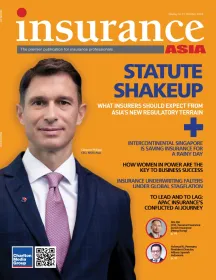
What risks insurers warn of in evolving motor insurance sector
Hong Kong’s push for EVs has insurers dissecting the risks and rewards in the evolving motor industry.
As autonomous driving technology and electric vehicles (EVs) transform the traditional motor insurance sector, Hong Kong’s government is offering substantial incentives to speed up this shift. However, insurers warn that a net-zero goal in the motor industry does not come without risks.
Whilst Hong Kongers are shifting gears towards electric and other new-generation car models, the government established the Steering Committee on the Promotion of EVs (SCPEV). Chaired by the Finance Secretary, it has recommended strategies to enhance energy efficiency, environmental benefits, and business opportunities.
The government’s push for EV adoption includes extending the first registration tax (FRT) concession for EVs until March 2026. It also aims for the expansion of public EV charger availability and the conversion of all new private cars to electric by 2035.
As of June this year, Hong Kong had about 96,600 EVs, representing 10.5% of the total vehicle population. The Transport Department has approved 326 EV models from 16 economies, including 254 models for private cars and motorcycles and 72 for public transport and commercial vehicles.
Industry adoption
Take Zurich Hong Kong, for example. The Swiss insurer witnessed a 22% year-on-year growth in gross written premiums and a 23% increase in motor policies last year, with the market share of EV policies increasing by 193% from December 2022 to December 2023.
However, extreme weather events, like the typhoon and heavy rainstorm in September 2023 that led to HK$1.9b in insurance claims, have highlighted the higher repair costs for EVs.
Zurich’s progress in the motor insurance segment can be attributed to several key factors. As Clement Hau, chief underwriting officer of General Insurance at Zurich Hong Kong, told Insurance Asia: “We see a positive growth trend in Hong Kong with the growing popularity of EVs, with the accelerated popularity driving an increase in the number of EV insurance policies issued and premiums collected in 2023.”

/Clement Hau, chief underwriting officer of General Insurance at Zurich Hong Kong.
The government’s extension of tax incentives for lower-cost EVs (below HK$500,000) underscores the long-term positive outlook for EV penetration in Hong Kong. As the first insurer to pledge to the Paris Agreement, Zurich integrates its Environmental, Social, and Governance (ESG) principles into its business operations comprehensively.
The company incorporates ESG factors into its investment decisions, risk management processes, and underwriting practices.
Zurich has set targets such as ensuring that 75% of its managed procurement spend is with suppliers that have science-based targets to reduce emissions by 2025 and achieve net-zero emissions by 2030.
The company also employs carbon footprint analysis to measure the emissions of its underwriting portfolio and uses life cycle assessments to ensure that its products are environmentally responsible.
For instance, Zurich’s EV insurance policy includes a service to help customers responsibly recycle their EV batteries, supporting the transition to a low-carbon economy.
“Regarding metrics or indicators, Zurich has both qualitative and quantitative metrics to measure the success of our sustainability initiatives such as percent of positions internally filled, percent of active learners in the area of work sustainability and emissions avoided through impact investment, percent reduction in operational carbon footprint in the pillar of environmental protection,” Hau added.
Evolution of motor
The gradual de-registration of petrol cars is expected over the next one to two decades, CBRE Research reported. The share of new energy vehicles, predominantly electric vehicles (EVs), is projected to rise from the current 12% of all registered cars to 43% by 2033 and 84% by 2046.
Meanwhile, the region’s heavy-duty autonomous vehicle market (excluding China) was valued at $34.8b in 2023 and is expected to reach $305.3b by 2032.
Growth drivers include improved safety features, reduced traffic accidents, and a shortage of drivers in sectors like public transport. However, infrastructure investment, regulatory challenges, psychological barriers, and financing the transition remain significant hurdles.
Different markets within the Asia Pacific region are also approaching regulation for autonomous vehicles at varying levels of maturity. For instance, China has issued guidelines to expand road testing for autonomous driving nationwide, whilst Japan has revised its Road Traffic Act to include provisions for drivers using automated driving systems. Singapore has designated specific zones for testing autonomous vehicles.
Vinay Surana, Regional Managing Director for the Asia-Pacific, Middle East, and Africa at Allianz Partners separately told Insurance Asia the need for global standards to ensure smooth technology adoption.
“We can’t afford to have local standards that vary from market to market because this could create significant challenges for manufacturers, software developers, and network providers,” he said.

/Vinay Surana, regional managing director for the Asia Pacific, Middle East, and Africa at Allianz Partners.
Risks in new-gen vehicles
One of the primary changes anticipated is a shift in risk from the driver to the provider, such as the OEM (Original Equipment Manufacturer), software provider, or network infrastructure provider.
“Currently, insurance focuses on the driver’s behaviour — how they drive, their speeding habits, braking, and driving history are the primary factors in determining insurance rates. In the future, as technology drives the vehicles, these considerations will become less relevant, and the risk will shift to the technology providers,” Surana said.
Whilst there is no direct correlation between the level of autonomy and electrification, investment in EVs is likely to drive innovation in autonomous technology. Issues such as wall box charging unit installations and battery warranties introduce new risks that insurers need to address.
“With an EV, when you install a wall box, that gas station is at your home. This introduces liability risks—if you live in a high-density building, improperly installing a wall box charger and wiring from your house could potentially cause a fire and burn down the building,” explained Surana.
The frequency and nature of claims will also undergo significant changes. With autonomous vehicles reducing incidents caused by driver error, there will be fewer claims. However, the severity of claims may increase due to the high cost of repairing advanced technology.
“Even a minor bump could result in costly repairs as every part of the car is equipped with sensors,” said Surana.
Enhanced accident reporting through data from vehicle sensors will also streamline the claims process, enabling OEMs to recreate accidents and identify key variables involved easily.
“In a connected environment where cars are driven autonomously and drivers may be disengaged, relying on the network and technology to drive the vehicle, there is the potential for cyber threats,” he warned.
What to look out for
Looking ahead, Zurich projects a 30% growth in EV penetration by 2026.
“Market trends and consumer behaviours support this projection, and Zurich is preparing to meet the anticipated increase in demand for EV insurance by continuously innovating its product offerings and enhancing customer engagement,” said Hau.
To prepare for the shift in claims management, insurers need to retrain their claims staff and rethink liability coverage. The industry will move from assessing claims based on driver fault to evaluating claims based on technology fault.
Establishing a robust data connection with OEM providers will be crucial.
“Our industry is data-rich but information-poor. We have a lot of data, but we don’t use it effectively. In an autonomous world, insurers’ ability to not only gather data but also extract insights from it will be crucial,” Surana stressed.



















 Advertise
Advertise


